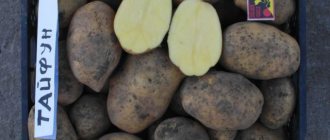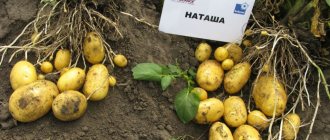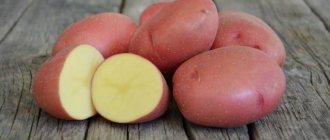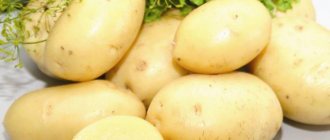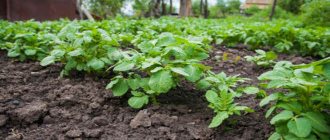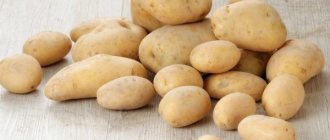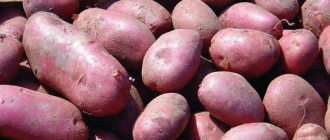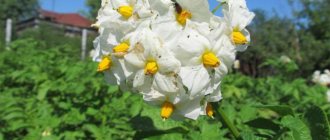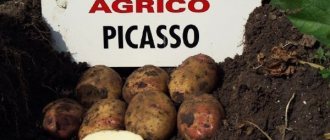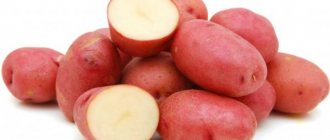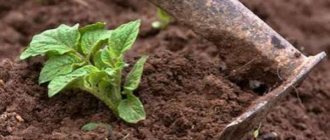Description of the potato variety Meteor
Escapes . Bushes of the Meteor variety are tall, semi-erect. The stems are powerful, the leaves are medium in size, but dense, dark green in color. During the flowering period, small white flowers appear on the bushes.
Roots. Potato tubers are round-oval with yellow skin. Meteor's flesh is also yellow. The eyes on the potatoes are of medium depth. The mass of root vegetables is small - from 100 to 150 grams.
Description and characteristics
In order not to make a mistake when buying planting material and to know what tubers you will end up with, you should first read the description of the Meteor potato.
Appearance of the variety
The Meteor variety has semi-erect, tall, intermediate bushes. The tops are well developed, the stems are quite powerful, the leaves are medium or large in size, dense, dark green in color. During the flowering phase, the bush is covered with small white flowers.
Root vegetables have a thin skin and a cream or yellowish color. On the peel you can see small eyes of medium planting depth. The pulp is also light, yellowish in color. Approximately 10-12 tubers are formed under each bush. On average, the weight of one commercial potato is 100-150 g, however, the weight of the fruit may vary in different growing conditions.
Taste qualities
This potato is loved by many summer residents and gardeners for its excellent taste. Meteor potatoes are table varieties; each tuber contains approximately 12-15% starch. It is noteworthy that potatoes are universal in use and can be used for preparing dietary dishes. It is best made into puree; it is also good stewed and fried. Root vegetables can be perfectly stored in vacuum bags. During heat treatment, potatoes do not darken or become boiled.
Characteristic
This variety has the following main characteristics:
- Potatoes do not darken when cooked and have a pleasant taste. The amount of starch in it is 12-15%, so Meteor is best suited for frying.
- The variety belongs to the super-early variety.
- Potatoes have high immunity and resistance to pests. It does not suffer from potato canker or golden cyst nematode. Meteor has average resistance to late blight, scab, rhizoctonia and rot.
- The variety is very resistant to drought and can easily adapt to any climate.
- The period from the first shoots to the technical maturity of potatoes is about seventy days.
- The variety has a good yield: 25-40 tons per hectare of land.
- The harvested crop is well preserved; experts estimate this quality at 95%. This means that during long-term storage, only 5% of the crop may be damaged.
- Under each bush there are 10-12 root crops.
- The regions most suitable for cultivation are: West Siberian, Central, Central Black Earth, Volga-Vyatka.
Pests and diseases
Good immunity of the variety is provided by the originators. Meteor is not affected by golden cyst nematode, potato canker, tuber blight, scab, rhizoctonia, and various types of rot. If the requirements of agricultural technology are violated, he may become ill with late blight of leaves and Alternaria. To prevent this from happening, it is necessary to follow all the rules for growing Meteor potatoes and carry out preventive treatment of the bushes with fungicides.
Dangerous pests include wireworms, Colorado potato beetles, mole crickets and field mice. In this case, spraying the plantings with insecticides, as well as observing crop rotation and traditional methods of controlling rodents, will help.
Advantages and disadvantages of the variety
As we have already mentioned, the Meteor potato variety has many advantages over other varieties. Among them are:
- early ripening of potatoes;
- pleasant taste;
- big harvest;
- long shelf life of the crop;
- resistance to heat and drought;
- high immunity;
- pest resistance;
- quick adaptation to any climatic conditions;
- a high percentage of marketable tubers - from 88 to 98%, which means that this is how much potatoes are suitable for sale (eating), and not just as planting material;
- can be grown in different regions;
- unpretentiousness;
- Suitable for growing in any type of soil.
The Meteor potato also has some disadvantages: the variety is demanding on the amount of nutrients in the soil. However, firstly, this factor is present in any type of crop, and secondly, the lack of vitamins can be easily compensated with the help of fertilizers, as well as by choosing the right place for planting.
Reviews about the variety
“There was no need to guess why the potato variety was called Meteor. The first acquaintance showed the advantages. We started enjoying jacket potatoes at the beginning of July, and planted them at the end of May. Tasty, unpretentious. The family is happy,” Tatyana and Sergey Smolyakov, Volgograd.
“Meteor potatoes are loved for their disease resistance. The absence of pesticides affects the purity of the product, this is valuable. I don't want to stuff myself with chemicals. We deal with the Colorado potato beetle simply: we monitor it and remove it in time, preventing the appearance of larvae,” Irina Zelenova, Samara region.
How to choose a landing site?
The Meteor variety prefers sunlit areas, so it should be planted where there is no shadow. Water should not stagnate on the site. And also choose a place where there are no strong winds, because they can damage shoots and even root crops. The soil for Meteor must be fertile, and it should also be fertilized regularly. The best type of soil for the Meteor variety is loam.
To get a good harvest, you need to maintain proper crop rotation. Given this rule, you will receive a generous harvest of delicious potatoes every year.
The best predecessors of Meteor potatoes are rye, pumpkin, legumes, onions, garlic, cucumbers, watermelon and melon. After these crops, the soil will be saturated with all the necessary nutrients, so by planting potatoes after these plants, after a while you will get an excellent harvest.
You should not plant potatoes after the following plants: tomatoes, hot and sweet peppers, sunflowers and eggplants. Also, do not plant vegetables in the same place for several years in a row, as the soil loses useful components and the potatoes do not have the resources for growth and development. As a result, the root crops remain small, and their quantity is much less than it should be.
You can use this method for planting: after harvesting, plant special plants - green manure, which will enrich the soil for the next planting. Siderates for potatoes include rye, mustard, rapeseed, alfalfa, phacelia, buckwheat and oats.
In addition, if you do not have the opportunity to change the location for growing, you can simply plant potatoes, alternating beds with rows. This little trick can save you if the dacha plot is small in area and there is nowhere to transplant the potatoes.
Video
It is almost impossible to find a worthy alternative to potatoes in your daily diet. Therefore, almost all gardeners strive to grow and harvest their own potato crop. As a rule, great importance is attached to the choice of variety. In this case, many factors are taken into account: the climatic characteristics of the region, the ripening time of the crop, the taste of the vegetable and the peculiarities of caring for the crop.
The Meteor variety cannot yet be called widespread, since it is quite young (only added to the register of varietal achievements in 2013). However, the excellent taste of the Meteor variety and ease of care ensure a significant increase in the number of its fans.
Landing dates
Typically, Meteor potatoes are planted in late April or early May, but the planting date depends on the growing region. Therefore, it is worth determining the time of planting by measuring the soil temperature. At a depth of 10 cm it should be 10 degrees.
There is also a folk method for determining the planting date - when the bird cherry tree blooms or the birch leaves become the size of a 10-kopeck coin.
But, regardless of the chosen method of determination, check the weather forecast. If frosts come again after the warmth, they can greatly harm the future harvest. The tubers will freeze and become tasteless, and their growth may also stop. Therefore, in this case it is better to wait until it gets warmer completely.
Soil preparation
In order for potato growing to be successful and bring a large harvest, the soil should be carefully prepared for planting tubers. To do this, the land must be cleared of weeds and past plants and crops, and then the necessary fertilizers must be added.
First of all, you need organic: manure (10 kg per 1 sq. m) or humus (5 kg per 1 sq. m). They will help nourish the soil and prepare it for planting potatoes.
Fertilizers should be added to the soil in the fall, and it should be dug up again in the spring. Also fertilize the soil with minerals: iron, magnesium, nitrogen, calcium, sulfur and phosphorus, potassium. Such preparation for planting will help add nutrients to the soil and subsequently grow tasty and healthy potatoes.
Possible diseases and pests of the variety, methods of combating them
Early potato varieties
, such as
Meteor,
are practically not susceptible to disease due to early ripening, but sometimes it is possible to become infected with certain
infections
and the appearance
of insects that
harm potatoes
To get a good harvest, you need to use high-quality seeds. The most productive varieties are possible. Large selection of varieties for every taste.
- disease .
It is characterized by the appearance of brown spots on the leaves, similar in contour to a target, and dark spots on potatoes. Timely treatment with fungicides (Quadris, Infinity, Flint) helps to cope with the infection. - Wireworm
is a yellow-brown worm (up to 3 cm) with a rigid body that eats tubers before emergence, young plants, and roots. Traps help fight it: put pieces of carrots, beets, potatoes (2-3 cm) on sticks and bury them 15-20 cm deep, leaving the end of the stick visible. Dig a trap after 30 days. Destroying weeds, in particular wheatgrass, and deoxidizing the soil help combat this pest. - The Colorado potato beetle
is an insect with stripes along its hard wings; its eggs are laid from the bottom of the leaf. The hatched larvae feed on leaves. Hand picking the beetles, treating them with Antizhuk and Komandor, and sprinkling the leaves with ash helps. - The mole cricket is
a long, hairy insect (up to 7 cm) of brown color that harms young plants and tubers. The drug Medvetox helps, checking the added humus for the presence of mole cricket larvae and refusing to add unrotted manure. - The field mouse
is a rodent that quickly destroys plantings. To combat it, a special poison is used and their nests are destroyed by digging.
Preparation of planting material
Before planting, it is necessary to remove diseased and weak tubers. And then stimulate the growth of planting material. The following mixture is suitable for this: dilute a tablespoon of copper sulfate, a few granules of potassium permanganate and 1 kg of wood ash in a bucket of water. You can also add urea (40 grams), superphosphate (60 grams) and boric acid (10 grams) to the solution. This will disinfect and also help protect the potatoes from pests. It should be kept in this mixture for about half an hour.
Then the tubers need to be sprouted. This is done about a month before planting. For about three days, the tubers are kept in bright light and warm up to +30 degrees, and then removed to a cooler place, with a temperature of +15.
If you missed the germination time, there is no reason to worry. For this case, there is a method that will help germinate tubers in a shorter time. It's called "wet". To do this, put the potatoes in a box and cover them with wet peat or humus.
Sometimes gardeners choose an even faster method: treat the tubers a couple of days before planting with growth stimulants. Then the germination procedure in advance is not necessary at all.
Features of care
Meteor is not too demanding to care for, but responds responsively to watering, fertilizing and loosening the soil. Maximum yield from the variety will be easy to achieve if you take into account a few simple features during further cultivation:
- Watering should be every 10-14 days. If it was raining at this time, there is no need to specifically water the soil. During dry periods, when there is no precipitation for a long time, the tops wither, the leaves curl, and the plant itself does not have enough moisture for development. Watering is carried out with cool water and strictly at the root of the potato bush;
- weeding and hilling. The ground must be weeded to remove weeds. You can hill up Meteor bushes when the tops reach a height of 10-15 cm. It is advisable to carry out weeding and hilling several times throughout the season, this helps to increase the number of tubers in the bush;
- treatment against diseases and pests. Meteor has a strong immune system, but it weakens over time, so infection is still possible. To protect against diseases, fungicidal preparations and folk remedies are used. Another danger to potato bushes is insects, in particular Colorado potato beetles. They can easily destroy all plants. Insecticidal additives work well against pests;
- application of fertilizers. For abundant fruiting, potatoes need to be fed several times a season. The first stage is carried out before flowering; during this period, you need to apply any nitrogen fertilizers to the soil. The second stage occurs in midsummer, when the tops begin to fade. Fertilizing is carried out with potassium sulfate or superphosphate. The third stage is carried out while the stems are withering, but no later than a month before digging. Water the plants with infusion of liquid mullein.
By the way, find out whether it is necessary to pick off flowers from potatoes during flowering and why?
Attention!
If the soil on the site is fertile, with a rich mineral composition, then there is no need for fertilizing. Excess fertilizers, on the contrary, only harm the development of vegetables.
When planting in early May, you can dig up potatoes from the end of June. You don’t even need a shovel for this, since the tubers are in the upper layers of the soil; just dig up the ground with a pitchfork. The tops need to be cut off and thrown away, otherwise they will only get in the way. Young tubers have a thin yellowish skin, so when cooking, you don’t have to peel it off, but just wash it well to remove the soil.
The main time for harvesting potatoes is in the second half of summer. Digging is carried out in dry, cloudy weather; the ground should be dry. The tubers are cleaned of soil and wiped dry, and then dried well for several days to remove moisture. If you store undried fruits for storage, their shelf life is significantly reduced. The room intended for vegetable storage should be cool (temperature within 4-10 degrees Celsius), moderately humid (humidity 30-60%) and without access to light. With proper storage, potatoes can remain completely intact until the next season.
How to plant Meteor potatoes?
When planting, leave 35 cm free between each future bush, and 60 cm between the rows. Tubers should be planted to a depth of about 10 cm. Before planting, it is useful to add fertilizer to each hole: 1 tbsp. l. nitrophoska or half a glass of bone meal, 700 grams of humus and 5 tbsp. l. wood ash.
By following this scheme, you will provide each bush with free space, so that everyone will have enough nutrients and moisture from the soil.
Growing Potatoes
Meteor potatoes are distinguished by their ability to adapt to various conditions and forgive novice gardeners the lack of experience in agricultural technology. However, this does not mean that its cultivation can be left to chance - following certain recommendations will help to obtain the maximum possible yield.
Landing
Meteor potatoes should be planted in late April-early May, when the soil warms up to 8–10°C. It is advisable to choose an area where winter crops, perennial grasses, legumes, cabbage, cucumbers or onions previously grew. The place should be well lit, not shaded by trees, buildings or fences. The ridges are best oriented from north to south.
According to the observations of experienced gardeners, the best guide for planting potatoes is bird cherry: as soon as it begins to bloom, you can begin planting.
The process of planting potatoes consists of several stages:
- The site must be prepared in advance, 2 weeks before planting, by digging it up and adding organic matter: rotted manure or peat. Organic matter can be added in the fall along with double superphosphate and potassium sulfate. Mineral fertilizers enriched with nitrogen, potassium, sulfur, phosphorus, magnesium and iron are also suitable.
- Potatoes are planted at a depth of 8–10 cm with a distance between holes of 35 cm and a row spacing of 60 cm. In rainy areas, plant in ridges - they prevent tubers from rotting.
Plant potatoes in prepared soil
- During planting, do not be lazy to add fertilizer to each hole. If you prefer organic fertilizers, add 5 tablespoons of ash and 700 grams of dry humus. You can also put 1/2 cup of bone meal and a tablespoon of nitrophoska in each hole. It’s also a good idea to use ready-made fertilizers - for example, Kemira.
Plant care
Proper care of potatoes includes feeding, loosening, hilling and watering. During the growing season, it is necessary to carry out at least 3 root feedings: at the beginning of the growing season, nitrogen should predominate in their composition, and during flowering - potassium.
If the bushes develop slowly, this indicates a lack of nutrients. In this case, you can carry out several root or foliar feedings - for example, mullein (1 liter of mullein per 10 liters of water, 2 liters per bush), urea (1 tbsp. per 10 liters, 0.5 liters per bush).
Potatoes should be watered three times a month, using an amount of water that will saturate the soil to a depth of at least half a meter. Ideally, it is worth organizing drip watering for the plants.
Drip irrigation is best for potatoes
Since Meteor is immune to most diseases, it practically does not require preventive treatments. However, periodic spraying of the bushes with an insecticide, for example, Karate, Actellik or Decis, will provide additional protection.
Video: how to harvest a large potato harvest
Potato care
Meteor is easy to care for, but still has some features.
Watering
This variety is drought-resistant, but it still needs to be watered every 10 days. In this case, you need to make sure that the water reaches the tubers, and not just covers the surface of the earth, otherwise the root crops will not receive enough moisture and nutrients, and this will lead to slow development, as well as to diseases.
Fertilizers
When planting potatoes, you need to take into account that the soil itself must be filled with the substances necessary for growth and development. But it is still better to feed the bushes so that you get a large harvest and the potatoes are not small. It is thanks to fertilizers that potatoes will receive all the necessary vitamins and nutrients that will ensure their proper development. About 3 of these dressings will be enough.
Please note that in rainy weather the plant needs fertilizer even more.
Mullein is the most suitable fertilizer. Dilute a liter of this substance in liquid form in a bucket of water and pour two liters of the solution under the bush.
Loosening and hilling
Already a week after planting potatoes, the soil should be loosened and weeds removed. Loosening should be superficial so as not to touch the tubers.
The meteor needs to be hilled only twice during the entire development period. The first time is when the height of the bushes is 15 cm, the second time – after 4 weeks.
Hilling is necessary in cold regions, especially if late frosts occur. This procedure helps protect the plant from freezing. However, in warm climate zones, you can do without hilling, because its main goal is to provide moisture to the tubers, and water also flows to the root crops through loosening and watering.
We suggest watching the video to learn in detail about how to hill potatoes and what equipment is needed for this:
Official data
The authorship was shared by such notable potato breeders as: Simakov E.A., Mityushkin A.V., Salyukov S.S., Zhuravlev A.A., Ovechkin S.V., Kravchenko D.V., Grigoriev D. V., Uskov A.I., Loginov S.I.
Among the originators are 15 potato research institutes and breeding stations that carried out scientific developments in the development of a highly productive variety.
Patent ownership of the variety belongs to the Federal State Budgetary Institution “VNII Potato Farming named after. A.G. Lorkha" Moscow region.
Work on the zoning of the variety has been carried out since 2008, and in 2013 the variety was entered into the register of varietal achievements of the Russian Federation under number 9154599, as very early and recommended for cultivation in the Central, Central Black Earth, Volga-Vyatka, Ural, and West Siberian regions.
zelenj.ru
Protection from diseases and insects
Potatoes of the Meteor variety are immune to most diseases and insects, but additional preventive measures will not hurt it.
The bushes need to be inspected regularly, and it is also advisable to sprinkle them with ash, this will prevent the appearance of Colorado potato beetles. To protect against wireworms, you need to reduce the acidity of the soil and remove wheatgrass.
In addition, to protect plants, you need to carefully spray them with insecticides. But even ordinary care, such as watering, digging the soil, weeding and loosening it, helps protect the crop from diseases and pests.
Features of cultivation
The list of measures for caring for the Meteor variety includes:
- Watering the ridges. Despite the high drought resistance of potatoes, lack of watering will significantly reduce its yield. During periods of drought, it is necessary to irrigate the plantings every 10 days. In small areas, installing drip irrigation can be a good help.
- Feeding. The early variety requires large amounts of magnesium and calcium. To feed potatoes, you can use mullein solution, Kemira, and complex mineral fertilizers. During the growing season, the variety needs 2-3 fertilizing on moist soil. The first before flowering begins is urea or ammonium nitrate. The second is needed in the period after flowering and before the tops begin to wilt. Now potatoes need phosphorus and potassium. It is recommended to feed Meteor a third time when the tops have completely withered. A solution of mullein or a mineral complex composition is suitable.
- Weeding and loosening. If the soil is loose and well-permeable, the tubers will develop quickly. The first loosening must be carried out a week after planting and at the same time remove weeds. Repeated - before hilling.
- Hilling. Meteor responds well to hilling, especially in areas of risky farming. The procedure saves the crop from frost and promotes the development of additional stolons.
To protect potato plantings from pest invasion, it is necessary to carry out preventive treatments with insecticides.
Hilling significantly increases the productivity of the variety
Harvest and storage
Meteor potatoes can be stored for a long time if you follow storage rules.
First of all, the harvested crop must be sorted and rotten and damaged potatoes removed. Then you should remove the remaining soil from the tubers, after which they should be laid out in a dark, ventilated place for 2-3 weeks, and then inspected and sorted again.
And only then you can place the potatoes in a place where they will be stored all winter. Remember that this place should be dark, with a humidity of about 75% and an air temperature of +1 to +6 degrees. Experts also advise going through the potatoes again in winter, removing the spoiled ones so that they do not damage the rest of the crop.
The Meteor potato variety has many advantages and, in addition, pleasant taste. He has a strong immunity to various diseases and is rarely damaged by insects. Caring for potatoes is quite simple and does not require much effort. Therefore, the Meteor variety is an excellent choice for growing for sale or for yourself.
0
0
Copy link
General characteristics of the variety
Meteor bushes grow tall, with medium-thick stems and dark leaves. White flowers are small in size. Each bush produces approximately 9-11 large potatoes.
The tubers are covered with a thin, cream-colored skin. The inner cut of this variety of potatoes has a light yellow color (as in the photo).
After planting, Meteor finally ripens in approximately 65-70 days, which makes it possible to classify it as an early ripening variety. There is an opinion that the potatoes are not dug until the color drops. However, for this variety it is possible to carry out the first “test” of the harvest after 43-46 days.
The Meteor variety is characterized by a high yield: 210-405 centners of tubers can be collected per hectare. Such a big difference is determined by the level of plant care, weather conditions, and location of the plots.
The distinctive quality of Meteor potatoes is excellent preservation, without loss of taste or appearance.
It is impossible to identify any significant shortcomings in the variety. It is quite natural that difficult weather conditions affect the size of the harvest. However, if you make every effort to properly care for the variety, the volume of the harvest will be quite satisfactory.
